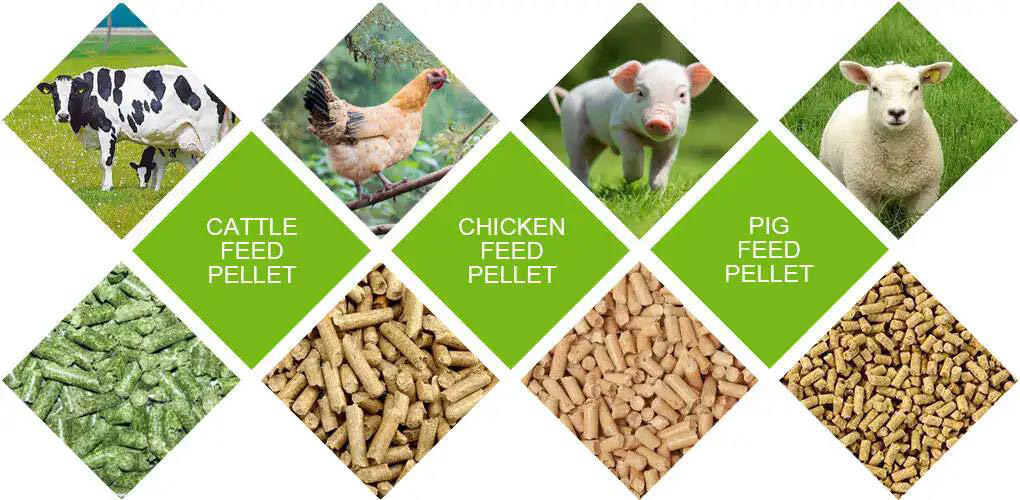cattle feed machine
A cattle feed machine is a mechanical device used to process cattle feed. It primarily processes various raw materials such as grains, legumes, and forage through mixing, grinding, pressing, or extrusion processes to produce pellets or powder suitable for cattle consumption.
cattle feed machine Introduction
A cattle feed machine is a mechanical device used to process cattle feed. It primarily processes various raw materials such as grains, legumes, and forage through mixing, grinding, pressing, or extrusion processes to produce pellets or powder suitable for cattle consumption. These machines can adjust feed formulations based on the nutritional needs and growth stages of cattle, ensuring balanced nutrition and supporting their health and efficient production.


Main features of cattle feed machine
Versatility
Capable of processing a variety of raw materials such as grains, legumes, and forage.
Nutrient Control
Allows precise adjustment of feed formulations to meet the specific dietary needs of cattle.
Processing Efficiency
Utilizes efficient mixing, grinding, and pelletizing or extrusion processes to produce high-quality feed.
Automation
Equipped with automated systems for consistent and efficient operation, reducing the need for manual intervention.
Durable Construction
Built with robust materials to withstand continuous use and harsh operating conditions.
Energy Efficiency
Designed to minimize energy consumption, reducing operational costs.
Feed Consistency
Produces uniform pellets or powder, ensuring consistent nutrient content in every feed batch.
Safety Features
Includes mechanisms to ensure safe operation and prevent accidents during the feed processing.
Easy Maintenance
Designed for easy cleaning and maintenance to ensure longevity and reliable performance.
Environmental Considerations
Incorporates technologies that reduce waste generation and support sustainable farming practices.


Main structure of cattle feed machine
Feeding System
Includes a hopper and feeder that evenly deliver various raw materials such as grains, legumes, and forage into the processing chamber.
Grinding System
Crushes the raw materials into fine particles suitable for further processing.
Mixing System
Uniformly blends the ground materials to ensure each feed pellet contains balanced nutritional components.
Conditioning System
Adjusts the temperature and moisture of the materials by adding water or steam to optimize processing conditions.
Pelletizing System
Core components include rollers, dies, and a main shaft that compress and shape the mixture into pellets.
Cooling System
Cools the pellets after pelleting to maintain their integrity and quality.
Cutting System
Cuts the pellets to the desired length to meet the feeding requirements of cattle at different growth stages.
Drive System
Consisting of motors, gearboxes, and transmission belts, it transfers power from the motor to various processing components to ensure the machine operates smoothly.
Lubrication System
Lubricates moving parts to reduce wear and friction, thus extending the machine’s lifespan.
Control System
Modern cattle feed machines are equipped with automated control systems that monitor and adjust processing parameters to enhance production efficiency and feed quality.


Main advantages of cattle feed machine
Nutritional Precision
Enables precise control over feed formulations to meet the specific dietary requirements of cattle, considering factors such as age, health, and production stage.
Feed Consistency
Produces uniform feed pellets, ensuring consistent nutrient content in each serving, which promotes better health and growth in cattle.
Increased Efficiency
Automates the process of mixing, grinding, and pelletizing, enhancing efficiency and reducing labor costs associated with manual feed preparation.
Improved Digestibility
Processes raw materials into forms that are easier for cattle to digest and absorb, maximizing nutrient utilization and reducing the risk of digestive issues.
Cost Savings
Reduces long-term feeding costs by improving feed utilization and minimizing waste.
Time Savings
Streamlines feed preparation and distribution, freeing up time for farm workers to focus on other essential tasks.
Customization
Allows for flexibility in adjusting feed recipes based on individual cattle needs and changing nutritional requirements over time.
Environmental Benefits
Utilizes energy-efficient technologies and reduces waste generation, contributing to sustainable farming practices.
Enhanced Safety
Includes safety features to prevent accidents during operation and maintain a safe environment for both operators and cattle.
Durability
Constructed with robust materials to withstand continuous use and harsh operating conditions, ensuring long-term reliability.
Application of cattle feed machine
Typically, the production of feed machine uses raw materials such as corn, soybeans, wheat, and other nutrients as the formula. Our pellet feed machine are specially used to produce feed for poultry, livestock, pigs, horses, cattle, sheep, chickens, ducks, goose and other animals.For different animals, with different growth cycles, (chicks, suckling pigs, calves, etc.), the feed pellet size required is different, but our feed production line only needs to replace ring molds with different apertures or use a pellet crumbler to reach the required size.

Parameter of cattle feed machine
| Model | Capacity | Main Motor Power | Feeder Motor Power | Conditioner Power | Dia. of Ring Die | Pellet Size |
| SZLH250 | 1-2T/H | 22KW | 0.75kw | 1.5kw | 250mm | 2-12mm |
| SZLH320 | 3-4T/H | 37KW | 1.5kw | 2.2kw | 320mm | 2-12mm |
| SZLH350 | 5-7T/H | 55KW | 1.5kw | 3kw | 350mm | 2-12mm |
| SZLH420 | 8-12T/H | 110KW | 1.5kw | 7.5kw | 420mm | 2-12mm |
| SZLH508 | 10-18T/H | 160KW | 2.2kw | 11kw | 508mm | 2-12mm |
| SZLH558 | 15-25T/H | 180KW | 2.2kw | 11kw | 558mm | 2-12mm |
| SZLH678 | 20-30T/H | 220KW | 2.2kw | 11kw | 678mm | 2-12mm |
| SZLH768 | 25-42T/H | 280KW | 2.2kw | 11kw | 768mm | 2-12mm |








